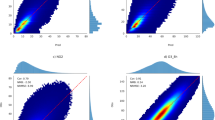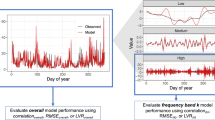Abstract
In order to get prepared for the coming extreme pollution events and minimize their harmful impacts, the first and most important step is to predict their possible intensity in the future. Firstly, the generalized Pareto distribution (GPD) in extreme value theory was used to fit the extreme pollution concentrations of three main pollutants: PM10, NO2 and SO2, from 2005 to 2010 in Changsha, China. Secondly, the prediction results were compared with actual data by a scatter plot. Four statistical indicators: E MA (mean absolute error), E RMS (root mean square error), I A (index of agreement) and R 2 (coefficient of determination) were used to evaluate the goodness-of-fit as well. Thirdly, the return levels corresponding to different return periods were calculated by the fitted distributions. The fitting results show that the distribution of PM10 and SO2 belongs to exponential distribution with a short tail while that of the NO2 belongs to beta distribution with a bounded tail. The scatter plot and four statistical indicators suggest that GPD agrees well with the actual data. Therefore, the fitted distribution is reliable to predict the return levels corresponding to different return periods. The predicted return levels suggest that the intensity of coming pollution events for PM10 and SO2 will be even worse in the future, which means people have to get enough preparation for them.
Similar content being viewed by others
References
BEGUERIA S, VICENTE-SERRANO S M. Mapping the hazard of extreme rainfall by peaks over threshold extreme value and spatial regression techniques [J]. Journal of Applied Meteorology and Climatology, 2006, 45(1): 108–124.
BELL M L, DAVIS D L. Reassessment of the lethal London fog of 1952: Novel indicators of acute and chronic consequences of acute exposure to air pollution [J]. Environmental Health Perspectives, 2001, 109(S3): 389–394.
MIJIC Z, TASIC M, RAJSIC S. The statistical characters of PM10 in Belgrade area [J]. Atmospheric Research, 2009, 92(4): 420–426.
LU H C, FANG G C. Predicting the exceedances of a critical PM10 concentration — A case study in Taiwan [J]. Atmospheric Environment, 2003, 37(25): 3491–3499.
HOROWITZ J, BARKAT S. Statistical analysis of the maximum concentration of an air pollutant: effects of autocorrelation and non-stationarity [J]. Atmospheric Environment, 1967, 13(6): 811–818.
SMITH R L. Extreme value analysis of environmental time series: an application to trend detection in ground-level ozone [J]. Statistical Science, 1989, 4(4): 367–393.
MCNEIL A J. Estimating the tails of loss severity distributions using extreme value theory [J]. ASTIN Bulletin, 1997, 27: 117–137.
BALKEMA A A, HAAN LD. Residual life time at great age [J]. The Annals of Probability, 1974, 2(5): 792–804.
PICKANDS J. Statistical inference using extreme order statistics [J]. The Annals of Probability. 1975, 3(1): 119–131.
CAIRES S, GROENEWEG J, STERL A. Past and future changes in the sea extreme waves [C] // 31st International Conference on Coastal Engineering. Hamburg, Germany: ICCE Press, 2008.
LU H C. Estimating the emission source reduction of PM10 in Taiwan [J]. Chemosphere, 2004, 54(7): 805–814.
TANCREDI A, ANDERSON C, O’HAGAN A. Accounting fir threshold uncertainty in extreme value estimation [J]. Mathematics and Statistics, 2006, 9(2): 87–106.
GILLELAND E, KATZ R W. Analyzing seasonal to inter-annual extreme weather and climate variability with the extremes toolkit [C] // 86th American Meteorological Society Annual Meeting. Atlanta: Georgia Press, 2006: 2–15.
ZHANG J. Likelihood moment estimation for the generalized pareto distribution [J]. Australian and New Zealand Journal of Statistics, 2007, 49(1): 69–77.
ATILLA A, KAAN Y, FERRUH E, ERCAN O. A neural network based approach for the prediction of urban SO2 concentrations in the Istanbul metropolitan area [J]. Environment and Pollution, 2010, 40(4): 301–321.
KARATZAS K D, PAPADOURAKIS G, KYRIAKIDIS L. Understanding and forecasting air pollution with the aid of artificial Intelligence methods in Athens, Greece [J]. Tools and Applications with Intelligence, 2009, 166: 37–50.
MIJIC Z, TASIC M, RAJSIC S, NOVAKOVIC V. The statistical characters of PM10 in Belgrade area [J]. Atmospheric Research, 2009, 92(4): 420–426.
KUCHENHOFF H, THAMERUS M. Extreme value analysis of Munich air pollution data [J]. Environmental and Ecological Statistics, 1996, 3(2): 127–141.
ERCELEBL S G, TOROS H. Extreme value analysis of Istanbul air pollution data [J]. Clean, 2009, 37(2): 122–131.
FENG J L, HU M, CHAN C K, LAU P S, FANG M, HE L Y, TANG X Y. A comparative study of the organic matter in PM2.5 from three Chinese megacities in three different climatic zones [J]. Atmospheric Environment, 2006, 40(21): 3983–3994.
Author information
Authors and Affiliations
Corresponding author
Additional information
Foundation item: Project(51178466) supported by the National Natural Science Foundation of China; Project(200545) supported by the Foundation for the Author of National Excellent Doctoral Dissertation of China; Project(2011JQ006) supported by the Fundamental Research Funds of the Central Universities of China; Project(2008BAJ12B03) supported by the National Key Program of Scientific and Technical Supporting Programs of China
Rights and permissions
About this article
Cite this article
Zhou, Sm., Deng, Qh. & Liu, Ww. Extreme air pollution events: Modeling and prediction. J. Cent. South Univ. Technol. 19, 1668–1672 (2012). https://doi.org/10.1007/s11771-012-1191-2
Received:
Accepted:
Published:
Issue Date:
DOI: https://doi.org/10.1007/s11771-012-1191-2




